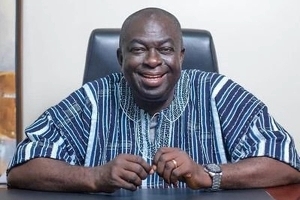Business News of Tuesday, 31 January 2017
Source: b&FT
Let’s consolidate power gains with coal – Jinapor
 Former Dpty Power Minister, John Jinapor urging gov't to follow through with the plan for coal power
Former Dpty Power Minister, John Jinapor urging gov't to follow through with the plan for coal power
The Nana Akufo-Addo-led administration should follow through with the plan for coal power and consolidate the gains made in the power sector, to bring down tariffs for industry, Former Deputy Power Minister, John Jinapor, has said, watering down environmental concerns critics have often raised about coal.
“In modern trends when we talk of coal, it is not the old coal system we are talking about. In modern technology, we are talking of coal supercritical, with carbon captured. With that technology, I will want to put on record that some of them are cleaner and environmentally friendlier than even light crude oil. It all depends on the technology that you go for.
And so, whilst I associate myself with concerns that environmental issues ought to be considered, I will want to appeal to him [Energy Minister] to take a look at modern trends because coal is one of the cheapest sources of energy. In fact, when you take thermal plants, coal is the cheapest; the advantage with coal is that you can do about a 1,000megawatts and so, I will want to appeal to the Minister that he takes a look at that,” he told B&FT.
Coal plays a vital role in electricity generation worldwide. Coal-fired power plants currently fuel 41% of global electricity and, in some countries, coal fuels a higher percentage of electricity.
The consideration of coal as an option for the country is driven by the growing demand. Currently, electricity demand stands at about 2,225MW. This is growing by 10 percent per annum and is expected to hit 7,000MW by 2030.
However, constraints on fuel sources for power generation -- crude oil, gas and water for hydro power generation -- have necessitated the need for exploring cost-effective, reliable, and clean power sources.
Given the current gas demand of about 450Mscf per day, indigenous gas and limited supply from the West Africa Gas Pipeline are unable to meet demand. Available indigenous gas is also expected to run out by 2036.
Coal, on the other hand, is available at a cheaper cost around the world. Advancements in coal power technology have also made it possible to generate clean power from coal.
Glencore Xstrata of South Africa is one of the notable companies with a large reserve of the commodity, and it exports millions of tons per year.
The company has about 30.2billion tonnes of reserves. The second largest coal supplier is Anglo America from Columbia, which has about 6.2billion tonnes of coal reserves.
“Today, we have an installed capacity of 3,855mw and so I will appeal to the new Minister of Energy, Boakye Agyarko, to concentrate on the financial sector, as he indicated, and I am sure that if he consolidates the gains we have made, “dumsor” will be a thing of the past.” Mr. Jinapor said.
At his vetting, however, Boakye Agyarko gave indication that he is not too keen on coal power, as he described it as a dirty source of fuel, adding that a lot of countries are de-commissioning their coal plants.
He told the Appointments Committee of Parliament, though, that he would ensure a stringent regulatory regime in the establishment of coal power plants in the country.
Coal power plants in the works
The Volta River Authority (VRA) and the Sunon Asogli Power Ghana Limited are both in the final stages of establishing coal plants.
Construction of Volta River Authority's proposed 700megawatt coal plant is expected to commence in April 2017, the Authority's tentative project timeline has shown.
The coal plant, to be sited in the coastal town of Aboano in the Ekumfi district of the Central Region, is expected to augment current generation and help the largest power producer diversify its power generation portfolio to meet the growing energy demand.
"Based on the project timelines, we expect to start construction on April 17, 2017. But that is also dependent on getting a permit from the Environmental Protection Agency. We are working closely with EPA to ensure that all the stringent environmental requirements are met," Ben A. Sackey, Manager, Environment and Social Impact-VRA said at a stakeholders meeting.
The coastal town of Aboano was selected as the ideal location after initial consideration of sites in Domunli, Akwidaa and Komenda purely on technical and economic bases, Mr. Sackey noted.
The coal power project is to be undertaken by the Volta River Authority (VRA) and its Chinese partner, Shenzhen Energy Group Co. Ltd. of China (SEC).
The China-Africa Development Fund (CADFund) is to provide about-US$1.5billion long-term loan for the construction of two 350MW coal-fired plants to meet future power demand.
This represents the first phase of developing coal plants by the largest power producer, as it seeks to strengthen the country’s base load and forestall any future shortage of power when existing plants are due for mandatory maintenance.
The plant is to be further expanded either by 4×350MW (or 2×600MW) supercritical coal-fired generating units in the future, as demand is expected to continue increasing. The project includes the construction of a coal port solely dedicated to taking delivery of imported coal.
Sunon Asogli is also seeking to generate about 700 megawatts of coal-generated power in the long-term.
Concerns by stakeholders
Various individuals and civil society organisations like the Ghana Youth Environmental Movement (GYEM), have kicked against the adoption of coal power, citing its environmental problems as a reason.
Green Peace International contends that: “Coal burning power stations continue to speed up global warming by filling the atmosphere with vast amounts of carbon dioxide. Coal burning leads to acid rain and smog, and emits more than 60 different hazardous air pollutants such as a variety of toxic metals, organic compounds, acid gases, sulphur, nitrogen, carbon dioxide and particulate matter.”
These concerns, VRA contends, are well addressed in the design and technology of the proposed coal plant. The state-owned power generator is proposing to use the latest clean-coal technology -- super critical -- in its first coal-plant.
“Domestic sewage water, coal waste water and oil wastewater will be treated separately, and then reused. Only circulating cooling sea water will be drained out of the plant. A thermal plume dispersion modelling is being undertaken to predict the permissible size of the mixing zone and the effect on sea. Effluent levels are to be monitored as part of the project monitoring plan.
We will conduct reasonable overall planning for the plant area; arrange high-noise equipment far from the area which is sensitive to noise; and reduce noise level by green-belt planting – that is planting arbor and shrubs on roadsides around the main powerhouse and nearby other sound sources as required, so as to reduce noise through the noise-reduction function of plants,” Mr. Sackey said.












